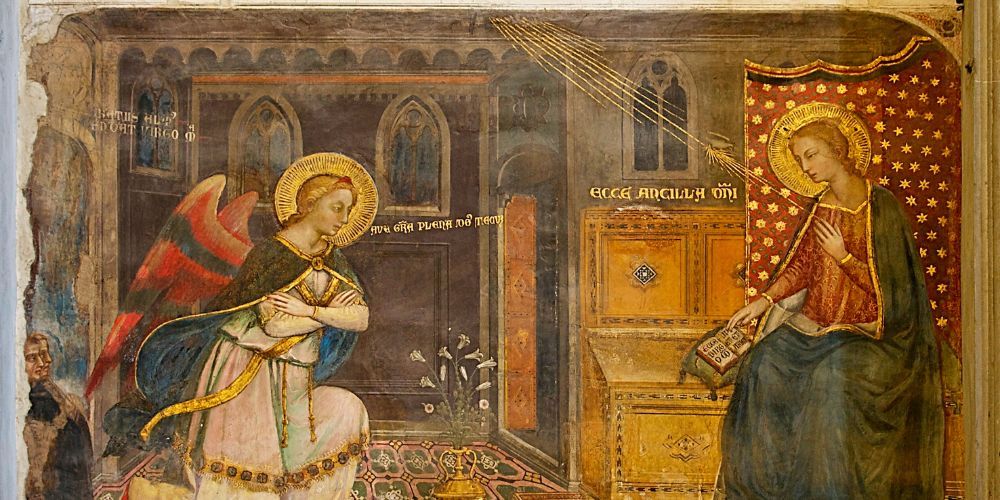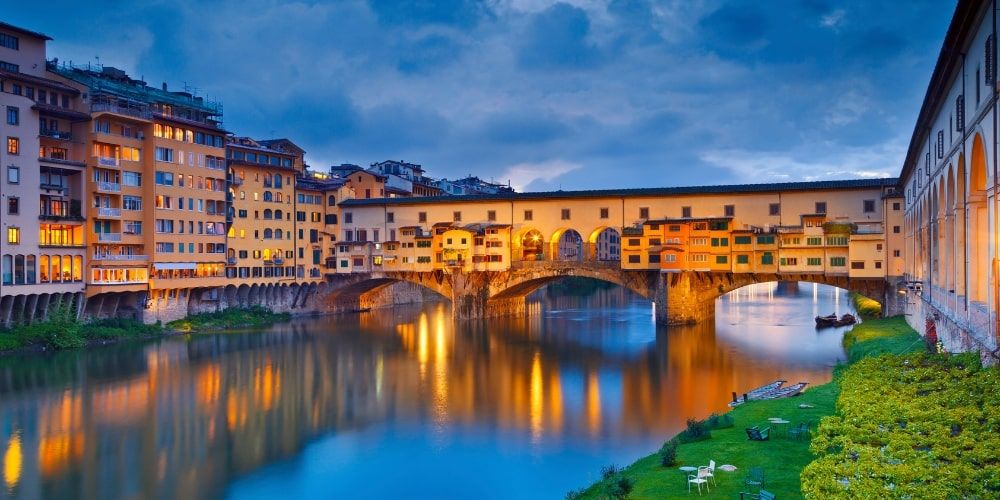
The Basilica of San Marco: a symbol of art and sacredness in Florence
St Mark's Basilica - Florence: the tickets most chosen by travelers

Florence: Audio-Guided Tour with a Live Guide
from 13.14 €

Heart of Florence Guided Walking Tour
from 19 €

Florence: Guided Walking Tour
from 138.6 €

Florence: Audio Guided Bike Tour
from 35.1 €
St Mark's Basilica: a place of art and spirituality in the heart of Florence
In the heart of Florence, St Mark's Basilica is a place of art and spirituality dating back to the 12th century. Founded as a Vallombrosan convent, it was renovated in the 15th century by the architect Michelozzo at the behest of Cosimo il Vecchio de' Medici.
Michelozzo designed the church, the pilgrims' hospice, the cloister, the library, and the monks' quarters. Beato Angelico, on the other hand, made the wall decorations together with his pupils.
The Basilica, consecrated in 1443 in the presence of the Pope, was renovated again in 1588 to a design by Giambologna, and the current façade was built between 1777 and 1778. The interior houses valuable works of art, including the 'Vision of St Thomas Aquinas' by Santi di Tito, the 'Madonna with Saints' by Fra Bartolomeo, and the large mosaic of the Virgin, dating back to 750 AD.
In former times, the walls were decorated with 14th-century frescoes, some striking traces of which remain today.
In 1866, the Dominican friars left the convent, and after a few years, the original cloister became a museum, where almost all the panel paintings by Beato Angelico, an important Renaissance painter, are on display.
St Mark's Basilica is a treasure to be discovered, a place where art and faith blend harmoniously.

Discover all other experiences
Useful information for visiting St Mark's Basilica
Opening Hours:
Monday: 9.30 - 12.30 / 15.00 - 19.00
Tuesday: 9.30 - 12.30 / 15.00 - 19.00
Wednesday: closed in the morning / 16.30 - 19.00
Thursday: 9.30 a.m. - 12.30 p.m. / 3 p.m. - 7 p.m.
Friday: 9.30 a.m. - 12.30 p.m. / 3 p.m. - 7 p.m.
Saturday: 9.30 a.m. - 12.30 p.m. / 3 p.m. - 7 p.m.
Sunday and public holidays:
10.00 - 12.30 / 16.30 - 19.00
Mass times:
Weekdays: 6.30 p.m.
Sunday and Holidays 11.00 a.m. and 6.30 p.m.
Confessions: Half an hour before Mass
Admission to St Mark's Church is free, and no reservation is necessary. In the case of large groups, a microphone and earphones are requested.
Please remember to cover your shoulders and knees when entering the church, especially in summer. You can use shoulder covers, scarves, or plastic cloaks, which are sometimes also available inside churches.
Admission to the St. Mark's Museum, adjacent to the church, is subject to a fee.
How to get to St Mark's Basilica
St Mark's Basilica is located in Piazza San Marco, in the historical centre of Florence. It can be reached on foot from the Santa Maria Novella train station in 20 minutes or by bus 32 and 23 and tram.
The best experiences in Florence
Best attractions around St Mark's Basilica - Florence
all entrance tickets for the most popular Italian attractions
Florence like a local: 10 things not to be missed
Do you want to visit Florence like a local? Then check our 10 things to do to live the city like a true Florentine.
Read more
Frequently Asked Questions about visiting St Mark's Basilica
What can you see inside St Mark's Basilica in Florence?
Once you have seen the elegant neoclassical exterior façade, the interior of the Basilica, with its side chapels designed by the Flemish sculptor Giambologna at the end of the 16th century, offers valuable 16th—and 17th-century paintings. On the right, one can admire the altarpiece by Santi di Tito, the Madonna and Saints by Fra' Bartolomeo, and the precious Byzantine mosaic of the Virgin at Prayer, dating back to the early 8th century. In addition, the last altar on the right has a painting of the Madonna of the Rosary and angels by Matteo Rosselli, as well as a statue of St Zenobi by Giambologna. The altars on the left are equally rich in valuable paintings, such as Cigoli's 1594 painting of Heraclius with the Cross, Anton Domenico Gabbiani's 1690 Mystic Marriage of St Catherine, and Passignano's 1593 Miracle of St Vincent Ferrer. The dome of the Basilica, designed by Angelo Ferri in the early 18th century, is also decorated with beautiful frescoes by Alessandro Gherardini. Finally, to the left of the presbytery, a Baroque portal leads to the Chapel of the Sacrament or Serragli Chapel. The vault of this chapel is also decorated with noteworthy frescoes.
How long does visiting the San Marco Museum in Florence take?
The San Marco Museum is part of the Convent of San Marco. A visit to the San Marco Museum can take up to 3 hours and includes the cloister of Sant'Antonino, the Sala dell'Ospizio, the Sala del Capitolo, the Sala del Refettorio, and the monks' cells. The museum spaces coexist with the adjacent St. Mark's Church. The parts adjoining the cloister of San Domenico are still reserved for monastic life and are not open to the public.
Opening hours: Tuesday to Saturday - 8.30 - 13.50 (last admission 13.20)
Admission: Full price € 8.00 - Reduced € 2.00 for EU citizens aged between 18 and 25.
Where can I see the works of Fra Angelico in Florence?
Giovanni da Fiesole, known as Fra' Angelico or Beato Angelico, was a Dominican friar and important Italian painter, one of the greatest exponents of the Renaissance. The San Marco Museum in Florence houses the world's most extensive collection of works by Fra Angelico, who lived in the San Marco convent for several years. Among the most important works is the Annunciation, which is considered a masterpiece of Renaissance painting. The Sala dell'Ospizio or Beato Angelico's Room houses the artist's other most famous works, such as the Deposition, the Triptych of St. Peter Martyr, the Annalena Altarpiece, the Last Judgement (1431), the St. Mark's Altarpiece, the Madonna and Child and the Tabernacle of the Linaioli. Beato Angelico also painted precious frescoes considered Renaissance masterpieces, which can be admired on the second floor of the building where the monks' cells once stood.
Frescoes in the Convent of San Marco in Florence
Beato Angelico painted several works on panel and frescoed, with the help of numerous pupils, the friars' cells, halls, and cloisters of the Convent of San Marco. He created over fifty frescoes and finished his work around 1450. Beato Angelico's works contributed to the creation of a complex of such high artistic value that today, part of the convent houses a museum dedicated to him.
In the dormitory on the monastery's first floor, Angelico decorated each cell with a scene from the life of Christ, depicting his moving and devout religiousness.
The frescoes are simple and easy to understand. Their main purpose was to inspire the friars during prayer.
Some of the most moving frescoes include Christ Mocked between the Virgin Mary and St Dominic and the Annunciation, a fresco depicted in 2 different convent rooms.
The Convent of San Marco in Florence
The Convent of San Marco, with its adjoining Basilica, is an essential stop when visiting Florence. This Dominican convent has played a very important role in the spiritual life of Florence over the centuries, thanks also to the illustrious personalities who have lived there, including Cosimo Il Vecchio, Beato Angelico, and Girolamo Savonarola.
Founded by Vallombrosian monks in the second half of the 13th century, it was later inhabited by Silvestrine monks and, finally, Dominican monks from Fiesole.
The convent was an important place for the Medici family, who resided in the area in the nearby Palazzo Medici.
In 1437, Michelozzo restored and enlarged the convent on the commission of Cosimo Il Vecchio. The interior decorations were by the Dominican friar and important Renaissance painter Beato Angelico. In the following centuries, numerous artists, including Baccio d'Agnolo and Giambologna, enriched the Convent and St Mark's Basilica with valuable works of art.
The San Marco Museum in Florence
The San Marco Museum in Florence occupies part of the Dominican convent of San Marco. It houses the world's most extensive collection of works by Beato Angelico, a friar and critical exponent of early Renaissance painting, who lived in the convent between 1438 and 1445.
The museum tour takes place between the cloister of Sant'Antonino, the Hospice Hall or Beato Angelico Hall, the Refectory Hall, the Chapter House and the monks' cells. Here, one can admire the frescoes and panel paintings by Beato Angelico. The second floor of the monastery houses the frescoes that decorated the monks' cells by Fra Angelico between 1438 and 1445.
Other works of great historical and artistic value by famous artists are also exhibited in the museum, first and foremost the Last Supper by Ghirlandaio, the Madonna and Child by Paolo Uccello and several paintings by Fra Bartolomeo, including the famous portrait of Girolamo Savonarola.
Finally, the museum is enriched by some architectural artefacts recovered during the 19th-century demolitions of the centre of Florence and the Michelozzo Library, the first public library of the Renaissance commissioned by Cosimo de' Medici, where the important early Renaissance philosophers Marsilio Ficino and Pico della Mirandola studied.






















Ilaria Capatti
This is all helpful information for visiting St Mark's Basilica in Florence. Discover the treasures of the Basilica and the adjacent Museum of San Marco.